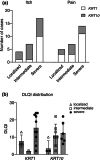Epidermolytic ichthyosis: Clinical spectrum and burden of disease in a large German cohort
- PMID: 38741524
- PMCID: PMC12023712
- DOI: 10.1111/jdv.20096
Epidermolytic ichthyosis: Clinical spectrum and burden of disease in a large German cohort
Abstract
Background: Keratinopathic ichthyoses are a group of hereditary skin disorders caused by pathogenic variants in keratin genes such as KRT1, KRT2 and KRT10, resulting in conditions such as epidermolytic ichthyosis (EI), autosomal-recessive EI, superficial EI and epidermal nevus. Case reports highlight the diversity of clinical manifestations, but only limited information exists regarding the quality of life and burden of disease.
Objectives: The objective of this study was to assess the clinical spectrum, genotype-phenotype correlations and burden of disease in patients with epidermolytic ichthyosis in Germany.
Methods: We conducted an observational study involving 48 patients diagnosed with EI. Evaluations included the severity of skin involvement using the Investigator's Global Assessment (IGA), the modified Ichthyosis Area Severity Index (mIASI) and complications. The burden of disease was evaluated using the Dermatology Life Quality Index (DLQI) or the Children's Dermatology Life Quality Index (cDLQI).
Results: Based on clinical features, mIASI and IGA, EI can be categorized into localized, intermediate and severe forms. Patients with keratin 1 mutations tended to have severe EI, while the three forms were evenly distributed in those with keratin 10 mutations. The study highlights that around half of the patients with EI experienced itch and severe pain. Quality of life was affected, with daily life restrictions of 78% due to care and therapies. Reimbursement for moisturizing ointments by health insurance was insufficient for one-quarter of cases.
Conclusions: The results emphasize the need for targeted interventions and comprehensive care strategies to enhance the quality of life for affected individuals.
© 2024 The Authors. Journal of the European Academy of Dermatology and Venereology published by John Wiley & Sons Ltd on behalf of European Academy of Dermatology and Venereology.
Conflict of interest statement
The authors state no conflict of interest.
Figures




Similar articles
-
Expanding the Clinical and Genetic Spectrum of KRT1, KRT2 and KRT10 Mutations in Keratinopathic Ichthyosis.Acta Derm Venereol. 2016 May;96(4):473-8. doi: 10.2340/00015555-2299. Acta Derm Venereol. 2016. PMID: 26581228
-
First Case of KRT2 Epidermolytic Nevus and Novel Clinical and Genetic Findings in 26 Italian Patients with Keratinopathic Ichthyoses.Int J Mol Sci. 2020 Oct 18;21(20):7707. doi: 10.3390/ijms21207707. Int J Mol Sci. 2020. PMID: 33081034 Free PMC article.
-
Treating epidermolytic ichthyosis and ichthyosis with confetti with epidermal autografts cultured from revertant skin.Br J Dermatol. 2024 Aug 14;191(3):397-404. doi: 10.1093/bjd/ljae193. Br J Dermatol. 2024. PMID: 38739763
-
[Clinical presentation and etiology of ichthyoses. Overview of the new nomenclature and classification].Hautarzt. 2010 Oct;61(10):891-902; quiz 903-4. doi: 10.1007/s00105-010-2018-4. Hautarzt. 2010. PMID: 20827455 Review. German.
-
Epidermolytic hyperkeratosis: a keratin 1 or 10 mutational event.Int J Dermatol. 2005 Jan;44(1):1-6. doi: 10.1111/j.1365-4632.2004.02364.x. Int J Dermatol. 2005. PMID: 15663649 Review.
Cited by
-
First successful treatment of epidermolytic Ichthyosis with Vunakizumab: A Case Report.Front Immunol. 2025 May 16;16:1574255. doi: 10.3389/fimmu.2025.1574255. eCollection 2025. Front Immunol. 2025. PMID: 40453098 Free PMC article.
-
Congenital Segmental Erosions and Hyperkeratotic Plaques in a Male Infant: A Quiz.Acta Derm Venereol. 2025 Jun 4;105:adv43154. doi: 10.2340/actadv.v105.43154. Acta Derm Venereol. 2025. PMID: 40468713 Free PMC article. No abstract available.
-
Brownish-Black Crusts and Erosions all Over the Body.Indian Dermatol Online J. 2025 May 26;16(4):698. doi: 10.4103/idoj.idoj_609_24. eCollection 2025 Jul-Aug. Indian Dermatol Online J. 2025. PMID: 40688135 Free PMC article. No abstract available.
-
Epidermolytic ichthyosis: New insights and ongoing challenges.J Eur Acad Dermatol Venereol. 2025 May;39(5):893-894. doi: 10.1111/jdv.20636. J Eur Acad Dermatol Venereol. 2025. PMID: 40277215 Free PMC article. No abstract available.
References
-
- Oji V, Tadini G, Akiyama M, Blanchet Bardon C, Bodemer C, Bourrat E, et al. Revised nomenclature and classification of inherited ichthyoses: results of the first ichthyosis consensus conference in Soreze 2009. J Am Acad Dermatol. 2010;63:607–641. - PubMed
-
- Ross R, DiGiovanna JJ, Capaldi L, Argenyi Z, Fleckman P, Robinson‐Bostom L. Histopathologic characterization of epidermolytic hyperkeratosis: a systematic review of histology from the National Registry for ichthyosis and related skin disorders. J Am Acad Dermatol. 2008;59:86–90. 10.1016/j.jaad.2008.02.031 - DOI - PMC - PubMed
Publication types
MeSH terms
Substances
LinkOut - more resources
Full Text Sources
Research Materials
Miscellaneous

